The deportations of 1941 and 1949 II WW2
6/14/1941 more than 15,400 Latvian citizens were deported from Latvia. Some of the deportees were immediately arrested and taken to prisons. The rest were settled in Siberia and Kazakhstan. This was the first mass deportation from Latvia.
In the autumn of 1939, immediately after the occupation of Latvia, the overthrow of its statehood began, the establishment and strengthening of the Soviet regime, as well as extensive repression against the so-called "enemies of the people" and "foreign elements". Following the example of the USSR, repressive institutions were established in Latvia in a short time, and USSR legislation came into force, incl. also the Criminal Code of the USSR, which opened opportunities for repressive institutions to punish Latvian citizens for their activities before the occupation of Latvia.
By order of the Main Archives Board of the USSR People's Commissariat of Internal Affairs, a special file of “socially dangerous elements” was created, in which compromising information about more than 10 categories of the population had to be recorded. Employees of the People's Commissariat of Internal Affairs and the People's Commissariat of National Security of the Latvian SSR used the archives of various state institutions, organizations, liquidated associations, publications of the independent Latvian press, reports of the State Statistical Bureau, as well as the issuance of USSR passports. related documents.
Along with the arrests of certain "anti-Soviet elements", which were immediately investigated and prosecuted, in Latvia, as in other areas of interest in the so-called Molotov-Ribbetrop Pact, preparations were launched for the widespread deportation to Siberia. The purpose of the planned deportation was to arrest and then in many cases take revenge on Latvian statesmen, army officers, court and police officers, members of political parties, prominent scientists, writers, teachers, and members of other professions and deport their families.
The deportation of more than 15 thousand Latvians on June 14, 1941, according to the orders and instructions of the USSR Government, the USSR National People's Commissariat of Security, the USSR People's Commissariat of Internal Affairs, was prepared by the LSSR National Security People's Commissariat with the support of LASCO, as well as employees of the Baltic Special War Area Headquarters, Part 3. In doing so, the troops of the USSR convoy, the People's Commissariat of the Interior and the militia, as well as local Communist Party and Soviet activists were involved in the deportation. The deportations took place mainly on the basis of "class signs" - those arrested for those who had been gathered about "counter-revolutionary" activities and "anti-Soviet agitation", as well as the wealthiest citizens of the former Republic of Latvia.
The Special Discussion of the USSR ICTY sentenced prisoners to death or imprisonment in camps for 3 to 10 years. More than 690 Latvians were executed. Some of those arrested, who had been sentenced to the highest sentence, died before they were executed. More than 3,400 citizens of the Republic of Latvia arrested on June 14, 1941 died in prisons. At the end of the 1940s, some prisoners were transferred from general correctional camps to the special camps of the USSR Ministry of the Interior, where the prison regime was even stricter.
Among those arrested, many were rural residents, who were repressed mainly as members of the Latvian security organization. On June 14, 1941, deported women, children and the elderly were deported to a lifelong camp in Krasnoyarsk Oblast, Novosibirsk Oblast and northern Kazakhstan, where they had to work in forestry companies, collective farms, and Soviet farms under the special command of the USSR Ministry of the Interior. More than 1,900 deported Latvian citizens died in the camps.
On June 14, 1941, the deportees were able to return to their homeland in the mid-1950s, and many only in the 1960s and early 1970s. In accordance with the UN Convention on Genocide of 9 December 1948 and the penalty for its deportation on 14 June 1941, it can reasonably be considered genocide against the Latvian people.
=====
3/25/1949 The deportation campaign "Krasta banga" (Прибой) started in Latvia, Lithuania and Estonia, during which 42,125 Latvians were deported to Siberia for life.
After the Second World War, the leadership of the Union of Soviet Socialist Republics (USSR) in 1939-1940. In the occupied and annexed territories in 1940, efforts were made to complete the 1940s and 1941s. The Sovietization of the region, which began in 2006, involved the amalgamation of individual farms into collective farms (Russian colossus, abbreviated to Russian colony) and the elimination of armed resistance. In order to achieve these goals, the 1948-1952 Deportations from these areas took place in. One of the shares was "Krasta banga" on September 25-30, 1949. In Estonia, Latvia and Lithuania. It was one of the largest post-war deportations in the USSR, as well as the largest deportation campaign in the Baltics (a total of 95,000 people were deported).
The data published by the State Archives of Latvia provide the most complete picture possible today of the victims of the deportation in 1949 in Latvia. March 25-30, 1949 deported 42,125 people from Latvia (2.2% of the Latvian population), i.e. sk. 16,869 men and 25,256 women. Among them were 10,987 children under the age of 16. Adding the number of children born on the way to Siberia, people deported or joining families after 30.03, the total number of deportation victims is 44,271. Most of them belonged to the “kulak” category - 67.7%. 94.5% of the deportees were Latvians, the next largest groups were Russians, Poles and Belarusians.
The deportation campaign started on March 25. after midnight. Each family was allowed to take 1,500 kg of luggage. It took one hour to collect. However, sometimes the task forces arbitrarily shortened the time to 15 minutes or less. There have been cases of soldiers, destroyers or activists engaging in maraudierism, robbery at the time of removal, or farms of already deported families.
The population of Latvia was deported to the Amur, Omsk and Tomsk regions. Upon arrival at the settlement site, a questionnaire was completed for each deportee who had reached the age of 16. They all had to sign that they had been deported for life under a decree of 26 November 1948. Escaping from the camp was punishable by 20 years in the cemetery. Special detainees were not allowed to move outside the administrative district without permission. Most of the deportees were employed in agriculture, mostly in collective farms.
Among the deportees were many people who were included in the lists due to negligence or error and whose deportation was illegal even under the rules of the time. However, complaints from the VDM and the MoI were generally ignored.
In 1954, the liberalization of the situation of special detainees began, and the release of “erroneously” deportees and some other categories began to be exempted. Decisions were made for each family separately, they were prepared by the Ministry of the Interior of the Latvian SSR, which made a decision on release. The materials were then sent to the LSSR Council of Ministers (MP). 5/19/1958 A decree of the Presidium of the Supreme Soviet of the USSR (APP) was adopted, exempting all "kulaks" from the special camp. The release did not mean the right to return to Latvia; the MP of the LSSR still gave permission to each family separately.
More information sources
https://www.vestnesis.lv/ta/id/25351
Deportation in Latvia on June 14, 1941 - National Encyclopedia (enciklopedija.lv)
Deportation on March 25, 1949 in Latvia - National Encyclopedia (enciklopedija.lv)
Your comments
Hello! Thank you for your comment. The description of this topic in Russian is a machine translation from Latvian. Original text in Latvian is available here: https://militaryheritagetourism.info/lv/military/topics/view/59 Best regards, "Lauku ceļotājs"
Related timeline
Related objects
Victims of Communist Terror Memorial in Torņakalns
The memorial site is located in the Torņakalns railway station in Riga. It is dedicated to those deported in June 1941. Initially it was planned to create a memorial in Esplanāde park, but later it was decided to place it at the Torņakalns station. The memorial consists of five torn stone sculptures symbolising the ruined families and three generations of deportees. The sculptor of this memorial is Pauls Jaunzems and the architect is Juris Poga. It was unveiled on 14 June 2001 by the then President of Latvia, Vaira Vīķe-Freiberga. Next to the station there is a freight waggon and a commemorative stone dedicated to the deported Latvians. The commemorative stone with the inscription “1941” is a 1.2 m high crude boulder. The author of the memorial stand is the sculptor Ojārs Feldbergs.
Exhibition in the KGB Building "History of KGB Operations in Latvia"
The former USSR State Security Committee (commonly known as Cheka) building is open for visitors. Here chekists imprisoned, interrogated and murdered Latvian citizens who were considered opponents by the occupation regime. There is also an exhibit from the Latvian Occupation Museum on the activities of Cheka in Latvia. Guided tours of the prison cells, corridors, basement and courtyard are available. The house was built in 1911 and it is one of the most beautiful buildings in Riga. Called the ‘Corner House’ by the people, it was the scariest symbol of the Soviet occupation regime in Latvia, and also one of the pillars of power of the USSR. Cheka operated from the Corner House during the occupation from 1940 to 1941 and then again from 1945 to 1991. Tens of thousands of Latvians were affected by direct political persecution. The fight against enemies of Soviet rule continued also after World War II. Cheka’s approach towards its operation slightly changed after Stalin’s death. Physical torture was replaced by psychological terror. The majority of Cheka agents were Latvians (52%). Russians were the second largest group – 23.7%. 60.3% of the agents were not members of the Communist Party. 26.9% of the agents had higher education. The system was designed in a way to involve local people and thus have greater control over the society. Staff documents and service records are located in Russia. And these materials have not been made available to Latvian authorities and researchers.
Gulbene Railway Station
The Gulbene Railway Station is located in the city of Gulbene. During World War I, in 1916 to 1917, the narrow-gauge railway line to Pļaviņas was reconstructed to 1,524 mm width to ensure that it can serve as a connection to the Rīga-Daugavpils line. In addition, a railway line to Ieriķi and to Sita was constructed, thereby establishing a connection with Pytalovo. As a result, Gulbene became a railway hub. The current station building by architect Pēteris Feders was constructed in 1926. During the War of Independence, on 31 May 1919, when Gulbene was liberated from the Bolsheviks, the 1st (4th) Valmiera Infantry Regiment collected a significant number of war trophies here. On 14 June 1941, both civilians and Latvian Army officers arrested in the Litene Summer Camp were deported from the Gulbene Railway Station. As a key hub, it was bombed in the spring of 1944. After the war, it was restored to its original form. An educational and interactive centre named ‘Railway and Steam’ was opened in 2018. Next to the Gulbene station is the company SIA Gulbenes – Alūksnes bānītis, which offers interactive lessons and tours. Visitors have access to the station building and platform, a memorial plaque and a monument to the repressed ones by sculptor Indulis Ranka.
Latvian Army Summer Camp in Litene
The Latvian Army Summer Camp in Litene is located in the forest in Litene parish, near the Pededze River. The beginnings of the Litene Camp can be traced back to 1935 when the construction of a summer camp complex for the Latgale division of the Latvian Army was started. From May to autumn, several thousand soldiers learned combat tactics and shooting skills in Litene. In the summer of 1941, Latvian Army officers were arrested by Red Army and NKVD troops at an army summer camp in Litene. Several officers were shot on the spot, while others were deported to Siberia. On 14 June 1941, at least 430 officers were arrested and deported to Siberia in the Litene and Ostrovieši camps about 10 kilometres from Litene. The only historical building that has survived from the camp is a food storage facility. Only the foundations remain from the other buildings. There is a viewing platform with the Latvian flag, benches and a well-maintained place for a fire. A demilitarised cannon was installed with the support of the Ministry of Defence and the National Armed Forces. Information boards are in place. The Wall of Pain memorial in the Litene graveyard is also connected with the events at the Litene camp. The YouTube channel of the Latvian Army features a video named ‘Litene, Katyn of the Latvian Army’.
Preiļi Museum of History and Applied Art exhibition "Museum stories for Latvia"
It is located in the premises of the Preiļi Cultural Center.
Preiļi Museum of History and Applied Art (PVLMM) exhibition "Museum stories for Latvia" about the First World War, the War of Independence and the Second World War can be viewed.
The "Story of Drywys" section of the exhibition "Museum Stories for Latvia" (opened in 2018) of the Museum of Preiļi History and Applied Arts is dedicated to the First World War, the War of Independence and the liberation of Latgale, as well as to the knights of the Lāčplešana War Order. The exhibition section "The story of the flag" tells about the difficult events of the Second World War period, during which the people of Preila were affected by deportations, the Holocaust, involvement in the military units of the warring parties, and after the war - in the ranks of national partisans. The "Righteous Among the Nations" medal awarded to Vladislav Vuškānas, the savior of the Jews from Preiliat, can also be viewed.
Upon prior application, a tour is available in Russian and English.
Museum of Melānija Vanaga and Siberian dugout
The Melānija Vanaga Museum is located in the Amata village school in Cēsis municipality. The museum showcases materials about the life, literary activity, family and destiny of writer and cultural historian Melānija Vanaga: video content about Siberia and the deported Latvians living there and a Siberian dugout taking its visitors on a trip to the writer’s place of deportation in Tyukhtetsky district, Krasnoyarsk region. The appearance and layout of the dugout form a realistic idea of life away from home. The dugout features unique historical objects brought there from the Tyukhtet Museum: a birch-bark dish known as ‘tuyesok’, a clay mug known as ‘krynka’ and a kerosene lamp. The museum features video interviews with politically repressed people from the municipality and 18 characters from Melānija Vanaga’s book Suddenly, a Criminal: Sixteen Years in Siberia. The museum’s virtual exhibition ‘BE YOURSELF!’ (http://esipats.lv) shows the experiences of five deported children and their parents who were wrongly accused by the Soviet authorities of ‘betrayal of the motherland’.
Valka train station
The Valka Railway Station is located at the end of Poruka street, next to a set of train tracks that are out of use. The station building can only be viewed from the outside where information stands of the importance of the railway in Valka and Valga are in place. Near the station building is a memorial stone devoted to the people deported to Siberia on 14 June 1941. The station building was constructed around 1896-1897. Narrow-gauge railway lines in the Valka-Rūjiena-Pärnu section were put in place here initially. During World War I, the railway was severely damaged. After establishing the state border, the Valka Railway Station (Valka II) became a border station. In late September 1920, the special Railway Board Commission arrived in Valka. The commission was authorised to negotiate and conclude an agreement with Estonia on the transfer of passengers from the station of one state to the other. The tracks between the triangularly placed Lugaži, Valka and Valga stations were strategically important, as they allowed armoured trains to turn around and move in the opposite direction. During the Soviet period, the USSR Army used this station to deliver ballistic missiles to Valka. A mass deportation of the Latvian people to the inland areas of the USSR took place on the night of 13-14 June 1941. More than 90 people from Valka and the surrounding areas were put in cattle waggons to be deported from the Valka Railway Station without any court judgement, prior warning or explanations. In September 1944, the station was destroyed by the retreating German Army.
Cattle wagon used for deportations – museum at Skrunda train station
To commemorate the deportations of June 1941 and March 1949, a memorial stone and a four-axle wagon, which also serves as the museum dedicated to deportations, was erected at the Skrunda railway station. This is the first wagon-type museum in Latvia that holds a permanent exhibit of photos, letters, memoirs, documents and various items made by the people deported from the Skrunda station. Skrunda station was a location where deportees were gathered, and one of the three stations in the region to which people from the Skrunda and the Kuldīga area were brought. In 1941, the family of the first President of the restored Republic of Latvia, Guntis Ulmanis, was deported from here to Krasnoyarsk Krai in Siberia.
With the help of deportations, the Soviets dealt with supporters of the national partizans’ and at the same time intimidated the remaining rural population, forcing them to join the collective farms.
Memorial place near Amata station - echelon No. 97322
It is located in Drabešu parish of Amata county, near the former Amata station building.
The deportees' memorial with an information board and a square can be viewed.
A total of more than 42 thousand people were taken from Latvia in 33 echelons on March 25, 1949 and the following days.
On March 27, 1949, at two o'clock in the morning, echelon No. 60 long wagons left Amata station. 97322 with 329 men, 596 women, 393 children.
The central object will be 1318 metal poles of various sizes and colors. Each of them symbolizes a person taken on March 25, 1949 from the then counties of Cēsis and Alūksne. On each column, the name, surname, year of birth and parish - from which the person was sent. At the moment, 21 posts have been installed with the support of the deportees themselves or their relatives.
The author of the idea, Pēteris Ozolas himself, also has his own pillar, who was taken from "Pērkonių" of Kos parish together with his family at the age of six on March 25, 1949.
Information about the deportation of 1949 and the operation "Priboi" (Coastal Wave) carried out by the repressive organs of the USSR in the occupied Baltic states, which was the basis of the deportation, can be read on the information board.
Luggage railway station
Located 3 kilometers from the city of Valka, on the left side of the highway Valka - Inčukalns (A3).
During World War II, the railway line Riga - Valka was of special importance. It served as the main supply artery for the Leningrad Front for the German army. The luggage station was established in 1942 as a precinct for the formation of military echelons in Valka. It had 12 tracks. The tracks between Lugaži, Valka and Valga stations, which formed a triangle with each other, were also of strategic importance in order to turn the armored trains in the opposite direction. Near the Pilenai's house (behind the station) is a collapsed guardhouse, which was used by German soldiers to monitor prisoners of war - railway workers.
Nowadays, the station building can only be seen from the outside.
A monument has been erected at the Lugazi railway station since March 25, 1992 to more than 600 citizens of the Republic of Latvia deported to Siberia on March 25, 1949 and before that. This is a work by architect Aivars Kondrāts based on the design of the monument to Jānis Sīmanis. It is shaped like a stone cut in half, which symbolizes the hearts of a divided Latvian family, essentially the entire nation with its culture and virtues, reminding of one of the darkest pages in the history of the Latvian people.
Memorial Wall of Pain
Artrodas Litene cemetery.
On June 14, 2001, the memorial “Wall of Pain” created by architects Dina Grūbe, Benita and Dainis Bērziņš, stonemasons Ivars Feldbergs and Sandra Skribnovskis was unveiled in Litene Cemetery, it symbolizes the resting place of the soldiers killed in 1941. In October 1988, the ashes of 11 officers killed in June 1941 by the Soviet Army were found in the territory of the former Latvian Army summer camp in Sita Silila, Litene Parish. Although they could not be identified, on December 2, 1989, at the consecration service in Gulbene Evangelical Lutheran Church, Litene Cemetery was solemnly reburied.
11 white crosses, memorial plaque and information stands.
Monument to the soldiers of Anna Parish who died in the First World War and the Latvian Liberation War
Located in the central part of Anna parish Ezeriņi cemetery.
In the cemetery, where the burials have been made since 1925, there is a monument to the soldiers of Anna Parish who died in the First World War and the Latvian Liberation War, built with the funds collected by the Department of Guard of Anna Parish and unveiled in 1933. Until the Second World War, the guards of Anna Parish took care of the care of the monument, who went to the cemetery every Sunday and laid flowers in honor of the fallen. On November 18, 1940, the monument was shot, and the footprints of the bullets are still visible. Today, the cemetery commemorates Lāčplēsis Day every year.
In 2004, a memorial to the politically repressed in 1941 and 1949 was unveiled in the cemetery, and in 2006 a memorial plaque to the national partisans was unveiled.
Memorial to the Cesvaine Victims of the First World War and the War of Independence in the Cesvaine Lutheran Church
Located in Cesvaine Lutheran Church and church grounds.
A memorial site for church members who died in the First World War and the War of Independence can be seen in the church.
In memory of the inhabitants of Cesvaine and its environs who died in the war of independence, a memorial place was restored and consecrated in the church in 2004, dedicated to the writer Augustus Saulietis in poetry.
All 34 surnames engraved on the old plate are also engraved on the plate. The wooden altar was made by a local master Juris Neimanis.
A memorial to the victims of the communist genocide, opened and consecrated on March 25, 2003, can be seen in the church garden.
The roof and foundations of the tower were damaged for the Cesvaine Evangelical Lutheran Church in World War II. In the post-war years, the organ, the altar, the pulpit and the lead frames of the window glass were destroyed. On March 29, 1964, the last service was held in the church, but in 1978, architect Maija Elizabete Mengele developed a reconstruction project for the church to be used as a house of tradition. In 1985, a group of craftsmen was formed to carry out interior reconstruction work. On August 25, 1990, the first service was held in the partially restored church, which was led by Archbishop Kārlis Gailītis (1936 - 1992). In 1994, the construction of the altar and pulpit was completed. On August 17, 2002, Archbishop Jānis Vanags consecrated the partially restored organ.
Source: http://www.cesvaine.lv/turisms/apskates-objekti-cesvaines-novada/cesvaines-luteranu-baznica.html
Monuments to the fallen and deported inhabitants of Palsmane Parish
Located near Palsmane Lutheran Church.
Monuments to be seen - the fallen and missing of the Latvian War of Independence, the fallen of the Second World War and the missing and the monument to the residents of Palsmane Parish deported in 1949.
The monument was unveiled in 1927 to the residents of Palsmane Parish who died in the Latvian War of Independence and disappeared. It was discovered by General Eduard Aire (1876–1933).
Funds for the creation of the monument have been donated by the associations and public organizations of Palsmane, Mērs and Rauža parishes.
Historical Exposition “The Burning Conscience”
The historical exhibit ‘Fire of Conscience’ is located in Cēsis, near the Cēsis Castle Square. Established in a Soviet-era temporary detention facility, it tells about the occupation of Latvia and reveals surprising and heroic stories of resistance from individuals. The yard features a memorial wall with the names of 643 residents of the former Cēsis district who died in Soviet repressions, including national partisans deported in 1941 and 1949 and those shot and sentenced to death. The exhibit’s timeline encourages visitors to study the course of the occupation of Latvia from 1939 to 1957. Arranged by topics, quotes from local newspapers offer a comparison of the political propaganda of the two occupation regimes. The six cells for temporary detention have survived to the present day in their original form from 1940 to 1941 and the post-war years. Here, the residents of Cēsis district, detained for various anti-Soviet activities, including national partisans, their supporters, young people who distributed anti-Soviet leaflets and other ‘traitors of the motherland’, were held for several days during the initial investigation and interrogation before being sent to the main KGB Building in Riga. Everything here is real: cells with iron doors, built-in ‘kormushkas’ (small openings for providing food), plank beds, a latrine for detainees, a small kitchen with an oven, as well as typical Soviet-era oil paint on the walls. In 2019, the exhibit was ranked third in the national design competition, the Latvian Design of the Year Award.
Exhibition "Struggles for freedom in the 20th century" in Jēkabpils History Museum
Located in Krustpils Palace
Viewable exhibition "Fights for freedom in the 20th century"
Soviet repression. Hard memories. Sitting here in a club chair, you can listen to fragments of the book "Those were the times" by Ilmars Knaģ from Jēkabpils. On one of the walls of the room, a list of townspeople deported to Siberia slides dispassionately, like the credits after a movie. There you can watch an amateur video about the removal of the Lenin monument in Jēkabpils on the old TV. Visitors are interested not only in the content, but also in the technical possibilities - how did this film get on the old TV.
It is possible to listen to the lectures prepared by the museum specialists at the Jēkabpils History Museum or apply for an excursion: Jēkabpils and its surroundings in the First World War, Jēkabpils in 1990, the time of the Barricades, the deportations of 1949 - 70, Jēkabpilians Cavaliers of the Lāčplēš Military Order, etc.
The average duration of lectures is 40 min. Information and registration for lectures by calling 65221042, 27008136.
Jēkabpils History Museum is located in Krustpils Castle. In 1940, after the inclusion of Latvia in the USSR, the 126th Rifle Division was stationed in Krustpils Castle. During the Second World War, the castle housed a German infirmary, and after August 1944, a Red Army war hospital. After the war, Krustpils Castle with the adjacent manor buildings were occupied by the central warehouses of the 16th Long-range Reconnaissance Aviation Regiment and the 15th Air Army of the Soviet Army.
A monument to the memory of the members of the Drustu parish who fell in the First World War and in the battles for the Liberation of Latvia
It is located near the Drustu Lutheran Church.
The monument was opened on June 19, 1932.
On June 14, 1931, the foundation stone of the monument was laid, on which the text "Hundreds of years will come and go, heroes will sacrifice themselves for fatherhood". A galvanized tin capsule with a memorial letter signed by the then Chief of Army Staff General Aleksanders Kalējs, parents of the fallen soldiers and other honored guests of the ceremony is embedded under it.
During the communist occupation, the text under the tab was cemented, but the bronze tab was hidden by the parishioners. When the Revival began, local activists of the Latvian People's Front cleaned the inscription and placed the preserved tab in its place.
41 members of the Drustu congregation who died in the First World War and the Latvian War of Independence have been identified.
Placed in the niches of the church wall are commemorative plaques for the victims of the communist terror - with 58 names of Drustenians and Gatartians carved into oak - the names of people whose graves are unknown.
‘Railway Tracks Remember’ monument to those deported from West-Estonia
This monument is situated in the small borough of Risti, next to its railway station.
Designed by Viljar Ansko, the monument was unveiled in 1999 and is dedicated to all of those deported from Western Estonia.
Risti station, the last stop in Lääne County, was the point from which not only the majority of the people from the local area, but also those from Pärnu and Rapla counties and the islands of Hiiumaa and Vormsi were deported to Siberia. A total of 3000 deportees passed through here along with people arrested in Lääne County. The 13-metre monument is mounted on a small railway platform with stone stairs at both ends. Four rails rise up into the air from the platform, which are bound together by a double cross made from rails. Aside from commemorating the mass oppression of the recent past, the cross also represents the history of Risti as a railway settlement.
Stende railway station in narrow gauge railway network and the memorial stone for deportations
The railway line Ventspils - Mazirbe, as well as the Stende - Dundaga extension to Mazirbe with a branch to Pitrags, were intended only for strategic military needs. During the construction of these lines, and afterwards, all civilians were evacuated from the region. The main task of the military railways in the Irbe Strait area was to provide the German army's coastal defence positions with guns and ammunition.
These military-only military railways also connected the three most important lighthouses, located in Oviši, Mikeltornis and Šlītere.
Nevertheless, passenger transport was also provided as early as the years of World War I.
A memorial stone (1989) to the deported Latvians of 1941 and 1949 is located at the Stende railway station.
On 30 October 1919, Stende railway station was occupied by Bermont troops. On 17 November, soldiers of the Latvian army led by K. Šnēbergs attacked the station, driving away a wagon with weapons, war materials and grain. 6 soldiers were awarded the Order of the Order for these battles: K. Bumovskis (1891-1976), P. Strautiņš (1883-1969), R. Plotnieks (1891-1965), E. Jansons (1894-1977).
Memorial ensemble for those who fought against Soviet occupation and victims of communist repression in the garden of Bauska Palace
The memorial ensemble in the Bauska Castle Garden was opened on the 90th anniversary of the Republic of Latvia – on November 18, 2008. The memorial site was created according to the idea of the Bauska region’s politically repressed club “Rēta”. The two-part grey granite monument was made according to the design of architect Inta Vanaga with the funds of the Bauska city municipality and donors. The text is engraved on it: “To the fighters against the Soviet occupation regime, those arrested, deported and tortured 1940-1990”. Every year on March 25 and June 14, memorial events dedicated to the victims of the deportations of 1941 and 1949 are held at this place
Vecumnieki Railway Station
Vecumnieki railway station is located south of the village of Vecumnieki.
Vecumnieki railway station was built in 1904 as a station on the Ventspils-Moscow railway line. Initially, it was called “Neugut” (during the German occupation in 1916/1917, it was called “Neugut Kurland”). It gained greater importance during the First World War, when a European-wide railway branch was built from it. In 1916, when the German army's front line had strengthened and stabilized along the left bank of the Daugava, on March 15, a decision was made to build a 25 km railway line with a track gauge of 1435 mm from Vecumnieki to Baldone (station: Mercendarbe - Merzendorf) for the needs of supplying the front. On March 30, about 5,000 workers began work, and by May 1, the line had been built to Skarbe station, and by May 6, to Mercendarbe. The sequence of stations from south to north was as follows: Neugut Kurland, Nougut Nord, Birsemnek, Gedeng, Skarbe, Merzendorf. At the largest of the stations, Skarbe, cargo was transshipped, from where it was transported to the front by horse-drawn transport. This railway existed for only a few years, as late as 1921, logs and firewood were transported along the railway line, until it was demolished in 1925. The location of the railway line is very different in different sections - in places it is crossed by roads of various importance, in places, as the embankment is clearly visible, it crosses forest massifs. There are places that are difficult to pass during the vegetation period.
At the former Gediņi station ("Bahnhoff Gedeng"), a narrow-gauge railway branched off in a northeasterly direction, the tracks of which continued towards the Daugava. At the Sila house it crossed Silupi (Kausupi) (former station "Bhf. Sille"), but at the Podnieki house it branched off. The first branch went to the right to Berkavas, and the second to the left to Vilki mountains and then returned to the broad-gauge (1435 mm) railway at the Skarbe station.
In September 1917, the Germans built another narrow-gauge railway line (gauge of 600 mm) from Mercendarbe and Skarbe to the Daugava, where they built a pontoon bridge and opened traffic all the way to Ikšķile on October 1. The flood of December 4 washed away the aforementioned bridge.
Since 1919, the station has been called Vecmuiža. In 1926, a stone building (architect J. Neijs) was built on the site of the wooden station building destroyed in the war. In 1940, the station was renamed Vecumnieki. In 2000, passenger train traffic was closed on the Jelgava—Krustpils line; currently, this line is used only for freight train traffic.
Arendole Manor
Arendole Manor was first mentioned in historical sources in the 16th century. Over the course of time, the owners of the manor have changed several times. The manor has belonged to the Grappenbruck, Lydinghausen-Wulf and Plater-Zyberk families. The manor house received its current look during the reconstruc tion between 1895 and 1901.
On 14 January 1921, on the basis of the agrarian reform law, the manor was expropriated and put at the disposal of the Kalupe Parish Board. The landlord house building of the manor was renovated and, in 1925, a primary school and an orphanage were founded there, while the home for the disabled of the war was established in the building of the servants’ house. The school and the home for the disabled were operating until 1975. In 1995, the building of the Arendole Manor landlords was pur chased by private owners and its restoration began. Since 2002, the association “Es Latgalei” (I am for Latgale) has been oper ating at the manor, which is taking care of its preservation and development. The visitors to the manor have the opportunity to see the reno vated premises and get acquainted with the largest collection of ancient objects in Latgale, as well as to learn about the histori cal events of the 20th century in Latgale. A special exhibition is dedicated to Jānis Babris, the former policeman of Kalupe Parish (1904–1982), who, on 14 June 1941, resisted a deportation task force, shot a militia operative, Slics, and wounded Communist Party plenipotentiary, Jozāns. Arendole Manor offers overnight stays and rental space for vari ous events.
Memorial "Path of Suffering"
A memorial site where a memorial stone was erected on June 14, 1989 to the people of Jelgava who suffered and died in the Soviet genocide against the Latvian people.
In 2008, in memory of those who died during communist repressions, a memorial "The Road of Suffering" was opened in Svētbirzē. It is designed as a railway embankment approximately twenty meters long.
Related stories
Deportation echelon secretly photographed at Skrunda station in 1949
On 25 March 1949, Elmārs Heniņš, a pupil in Skrunda, witnessed his classmates being taken away. He took his camera and climbed a pine tree on a nearby hill to document what was happening, later hiding the pictures.
Küüditamine 1949 Valgamaa peres
On 25 March 1949, the second major wave of deportation from the Baltic Republics took place. In Estonia almost 21 000 people (7,500 families) were sent to Siberia. The story is about the family in Valga county.
Historical evidence in the rocks of Līču - Langģi
Excerpts from local history enthusiast Aivars Vilnius tell about history and its evidence found in Lode and Liepa, now in Cēsi county.
A nine-year-old's journey into exile
Writer Regina Guntulytė-Rutkauskienė, who was exiled at the age of nine, remembers the deportation of June 14, 1941, when she and her family were taken to Siberia. Her story reveals not only the physical but also the emotional pain of exile, which accompanied her even after returning to Lithuania.




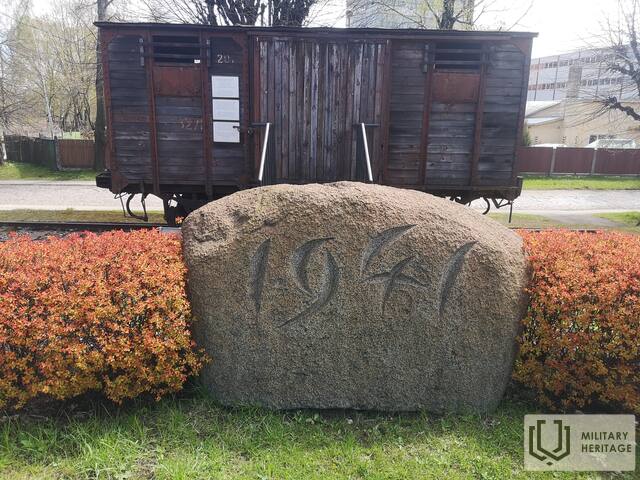


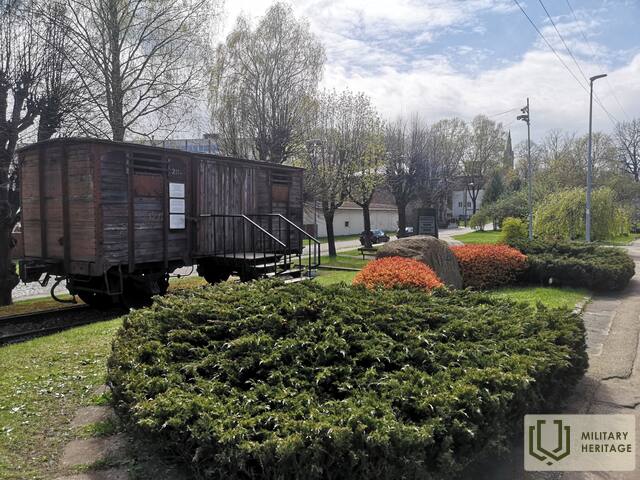
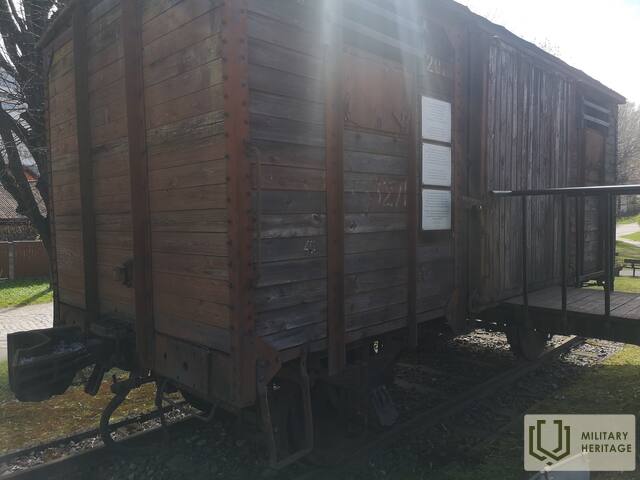
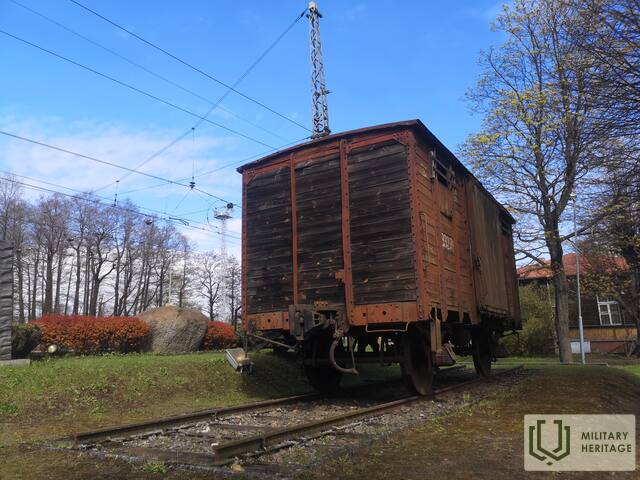
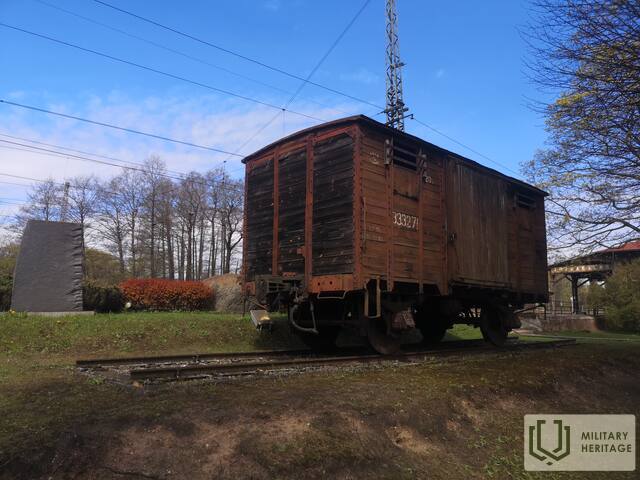

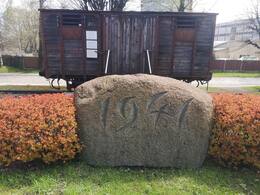
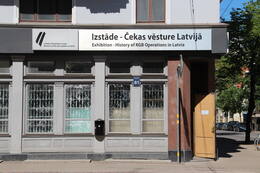
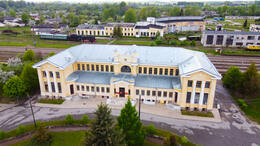
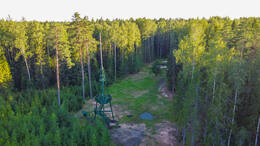
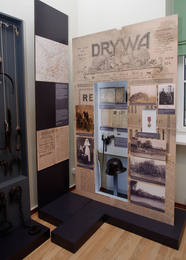
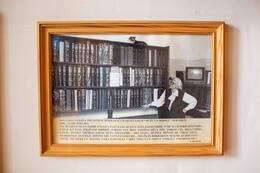
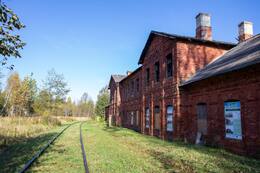
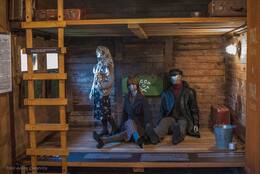
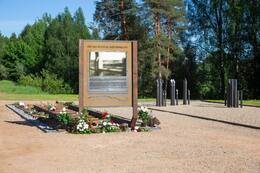
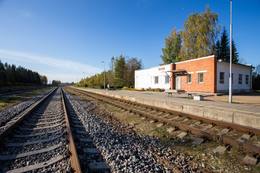
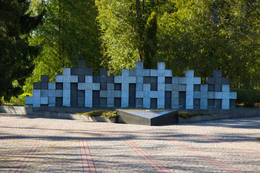
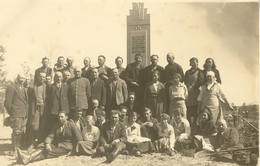
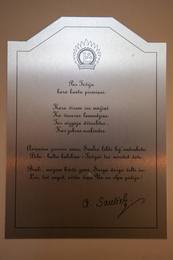
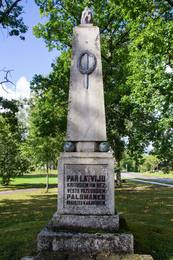
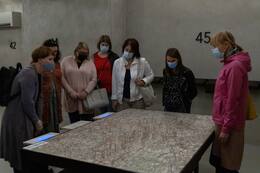
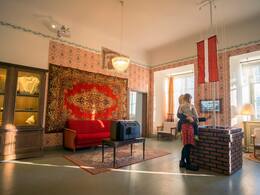
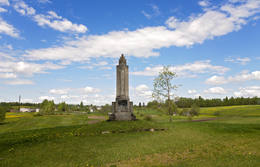
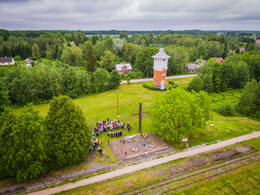
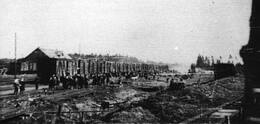
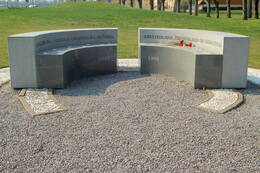
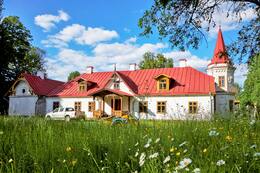
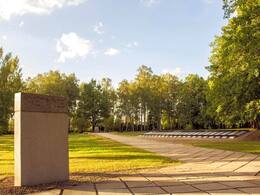
After World War II, the leadership of the Union of Soviet Socialist Republics (USSR) in the occupied and annexed territories of 1939-1940. , efforts were made to complete the Sovietization of the region, which began in the 1940s and 1941s, and which included the consolidation of individual farms into collective farms and the elimination of armed resistance. To achieve these goals in 1948-1952. deportation operations took place from these areas. One of the operations was “Krasta Banga” on September 25-30, 1949 in Estonia, Latvia and Lithuania. It was one of the largest post-war deportations in the USSR, as well as the largest deportation operation in the Baltic states (a total of 95 thousand people were deported). For escaping from the camp, he was sentenced to 20 years in the cemetery. ??? (hard labor) In 1954, the liberalization of the situation of special prisoners began, they began to exempt them from release ????? (deportation) of “wrongly” deported and some other categories.